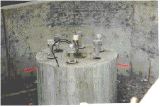


| -------- -------- & Specials -------- |

©1996-2001 |
|
-----
Many things these days cost a lot of money, and these tunnels were no different. The ceramic tiles cost a total of $1.5 million. It cost 16.3 million to buy the fans and the other ventilation equipment, and $18.5 million just to install it. The tunnels themselves will cost about $150,000 a year for electricity alone. All in all, the tunnels cost $350 million and were finished by September of 1997, after 7 years of work. The grand total for the entire H-3 freeway is $1.1 billion.
The H-3 tunnels, because they are so long (Kaneohe bound: 5,165 feet; Halawa bound: 4,690 feet), need a lot of extra stuff to help them run. One of the main things with the H-3 tunnels is the Halawa Control Center. This center helps to run the tunnels. Workers in the control center can change lights and signs in the tunnels to warn drivers, or they can override all A.M. and F.M. frequencies and speak to drivers directly over their radios. There are ten passages that connect the two tunnels, allowing people to move to the other tunnel in case of an emergency. Computer sensors in the tunnels click 240 times a second and record all sorts of information about the tunnels. If the carbon-monoxide levels get above 15 parts per million, then computers automatically turn on the 200 horsepower fans. There are stairs connecting the upper layers of the tunnels and even an elevator. On the Halawa side of the tunnels, there is a 100 foot tall light pole that lights the entire area around the entrance to the Halawa portals.
This picture above is of the base of the 100' pole. A ring on top holds about 30 light bulbs on it and the pole can be lowered down if the light bulbs need to be changed. The tunnels are tallest in the center, reaching a height of 1,044 feet. The tunnels would normally stick out so the tunnel portals are designed to lean backward with the slope of the mountain and the concrete on the outside of the tunnels is dyed with a black pigment (it would reach this color naturally after 10 years). With all of this, the H-3 tunnels are the longest in the state and one of the most technologically advanced in the nation.
Special thanks to Mr. Don Siddal and Mr. Charles Fell. Mr. Siddal is an electrical engineer who worked on the H-3 tunnels. He worked on the lights and other electrical aspects of the tunnel. Mr. Fell is the H-3 tunnel field director. He is in charge of the entire tunnel section of the H-3 freeway. These two men provided much of the information for this report.
- Gibbons, Gail. Tunnels. New York: Holiday House, 1984
- Dunn, Andrew. Tunnels. New York: Thomson Learning, 1993
- Honolulu Star-Bulletin: Blasting sets 20-ft-per-day pace in H-3 Freeway Exploratory Haiku valley tunnel August 24, 1989
- Honolulu Star Bulletin: H-3 Trans Ko'olau Tunnel crews, equipment, & process described December 14, 1989 A-1
- Honolulu Star Bulletin: Facts about H-3 Tetsuo Harano Tunnels November 23, 1994 A-6
- Honolulu Star Bulletin: Tunnels Vision; H-3 Tunnel is futuristic, expensive, & ready to use December 16, 1994 A-1
- Honolulu Star Bulletin: H-3 tunnel consists of many engineering feats December 16, 1994 A-8
- Honolulu Advertiser: H-3: Slow-going, dollar guzzling July 9, 1995
(many of the Honolulu Star Bulletin articles can be found at their web site)




